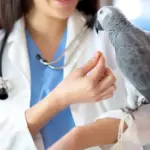
Egg binding:that remain “bound” inside a hen can lead to very serious medical problems and sometimes even sudden death. Eggs are usually passed without difficulty and on schedule. However, occasionally such factors as reproductive disorders, excessive egg laying, generalized diseases including infections, and nutritional deficiencies or excesses can lead to egg-binding.
Signs
An egg-bound hen will lay eggs unsuccessfully. She may sit on the floor of her cage and may also be panting, depressed, fluffed, and lethargic. The eggbound hen may also appear partially paralyzed in one or both legs and may have a swollen abdomen. An egg may or may not be visible from the vent.
Home Treatment
Home care can be attempted, however, if no egg is passed, precious time will be lost. Therefore, please consider contacting your avian veterinarian before trying to treat the problem.
Increase the environmental temperature to 85° to 90° F, increase the humidity. Place her in a “steamy” bathroom. Create a small tent over the cage using plastic sheeting and turn on a vaporizer for about an hour at a time. A wet, warm towel on the cage floor may also help. Regardless of what method you use to raise the humidity, be careful and don’t “overcook” your parrot!
Provide her with energy supplements in her water sources, such as Gatorade, Karo syrup or a little sugar.
EGG binding in parrot Sings and Treatment
SOURCE:Love of Pets
Veterinary Treatment
Treatment, of course, depends on the condition of the parrot. After the initial exam and general supportive care, a radiograph may be recommended to not only confirm the diagnosis but also to determine the size, shape, and calcium content of the egg. Medication is used to first try and stimulate contractions to aid in pushing the egg out. If medication alone doesn’t work, the hen may need to be anesthetized by relaxing the hen and her muscles, along with a little lubricant, it often allows for the egg to be gently manipulated and removed. If this also fails, other treatments including surgery to remove the retained egg may be necessary.
How to Treat Egg Bindin

Egg binding parakeet Prevention
To prevent egg binding parakeet, keep breeding hens healthy and provide them with good diets. If your parrot lays eggs, you can try and prevent eggs from being produced by lowering the breeding stimuli in the parrot’s environment. To do this, remove the nest box from the parrot’s cage, take away her favorite toys, do not provide her with a mate, and limit the parrot’s exposure to light to between eight and ten hours a day.
Hens with recurring egg-laying problems may be candidates for medications that can prevent eggs from being a producer or for surgery to remove the reproductive tract;(i.e., hysterectomy). Discuss these options with your veterinarian.
EYE INJURY
All eye problems should be considered potentially serious and could lead to serious infections and even blindness.

EGG binding parrot Sings
Signs of eye injury include a swollen or closed eye, increased blinking or squinting, rubbing of the eye or discharge from the eye.
The surface of the eyeball could lose its normal transparency and appear “cloudy” or “hazy”.
Home Treatment
As mentioned, any eye problem should be considered seriously. Home treatment will delay proper veterinary care that could mean the difference between saving or losing an eye.
However, home treatment should first include examining the eye carefully for any tiny foreign objects. Obviously, magnification usually helps you see if there is something there. The eye could be rinsed with plain tap water or with over-the-counter eyewash for humans, such as a saline solution or contact lens wetting solution.
No other safe home treatments can be suggested for eye problems. Please consult your avian veterinarian.
Veterinary Treatment
After the history and general exam, the eye will be closely examined. A special eye stain will usually be applied to determine if a scratch or abrasion exists on the surface of the eyeball. An ophthalmoscope may be used to further examine the inside structures of the eye. Treatment usually consists of eye medications that will need to be instilled into the affected eye several times a day until healed. surgery is occasionally necessary to repair an injury or to temporarily cover the eye to protect it.




















